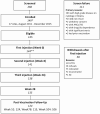High Prevalence of Anal High-Grade Squamous Intraepithelial Lesions, and Prevention Through Human Papillomavirus Vaccination, in Young Men Who Have Sex With Men Living With Human Immunodeficiency Virus
- PMID: 33991185
- PMCID: PMC8528397
- DOI: 10.1093/cid/ciab434
High Prevalence of Anal High-Grade Squamous Intraepithelial Lesions, and Prevention Through Human Papillomavirus Vaccination, in Young Men Who Have Sex With Men Living With Human Immunodeficiency Virus
Abstract
Background: Men who have sex with men (MSM) are at high risk for human papillomavirus (HPV)-related anal cancer. Little is known about the prevalence of low-grade squamous intraepithelial lesions (LSILs) and the anal cancer precursor, high-grade squamous intraepithelial lesions (HSILs), among young MSM with HIV (MSMLWH). HPV vaccination is recommended in this group, but its safety, immunogenicity, and protection against vaccine-type HPV infection and associated LSILs/HSILs have not been studied.
Methods: Two hundred and sixty MSMLWH aged 18-26 years were screened at 17 US sites for a clinical trial of the quadrivalent (HPV6,11,16,18) HPV (qHPV) vaccine. Those without HSILs were vaccinated at 0, 2, and 6 months. Cytology, high-resolution anoscopy with biopsies of lesions, serology, and HPV testing of the mouth/penis/scrotum/anus/perianus were performed at screening/month 0 and months 7, 12, and 24.
Results: Among 260 MSMLWH screened, the most common reason for exclusion was detection of HSILs in 88/260 (34%). 144 MSMLWH were enrolled. 47% of enrollees were previously exposed to HPV16. No incident qHPV type-associated anal LSILs/HSILs were detected among men naive to that type, compared with 11.1, 2.2, 4.5, and 2.8 cases/100 person-years for HPV6,11,16,18-associated LSILs/HSILs, respectively, among those previously exposed to that type. qHPV was immunogenic and safe with no vaccine-associated serious adverse events.
Conclusions: 18-26-year-old MSMLWH naive to qHPV vaccine types were protected against incident qHPV type-associated LSILs/HSILs. Given their high prevalence of HSILs, there is an urgent need to vaccinate young MSMLWH before exposure to vaccine HPV types, before initiating sexual activity, and to perform catch-up vaccination.
Keywords: anal human papillomavirus infection; anal squamous intraepithelial lesions; human immunodeficiency virus; men who have sex with men; quadrivalent HPV vaccine.
© The Author(s) 2021. Published by Oxford University Press for the Infectious Diseases Society of America.
Figures


Similar articles
-
Effectiveness of the Quadrivalent HPV Vaccine in Preventing Anal ≥ HSILs in a Spanish Population of HIV+ MSM Aged > 26 Years.Viruses. 2021 Jan 20;13(2):144. doi: 10.3390/v13020144. Viruses. 2021. PMID: 33498165 Free PMC article. Clinical Trial.
-
Prevalence of Anal Human Papillomavirus Infection and Anal High-Grade Squamous Intraepithelial Lesions Among Men Who Have Sex With Men 50 Years and Older Living With or Without HIV.J Acquir Immune Defic Syndr. 2024 Aug 15;96(5):439-446. doi: 10.1097/QAI.0000000000003450. J Acquir Immune Defic Syndr. 2024. PMID: 38985441 Free PMC article.
-
Efficacy, immunogenicity, and safety of a quadrivalent HPV vaccine in men: results of an open-label, long-term extension of a randomised, placebo-controlled, phase 3 trial.Lancet Infect Dis. 2022 Mar;22(3):413-425. doi: 10.1016/S1473-3099(21)00327-3. Epub 2021 Nov 12. Lancet Infect Dis. 2022. PMID: 34780705 Clinical Trial.
-
Prevention and management strategies of anal squamous cell carcinoma among men who have sex with men living with HIV.Int J STD AIDS. 2025 Jun;36(7):533-541. doi: 10.1177/09564624251333035. Epub 2025 Apr 13. Int J STD AIDS. 2025. PMID: 40221878 Review.
-
Epidemiology of anal human papillomavirus infection and high-grade squamous intraepithelial lesions in 29 900 men according to HIV status, sexuality, and age: a collaborative pooled analysis of 64 studies.Lancet HIV. 2021 Sep;8(9):e531-e543. doi: 10.1016/S2352-3018(21)00108-9. Epub 2021 Jul 30. Lancet HIV. 2021. PMID: 34339628 Free PMC article.
Cited by
-
Prevention and Treatment of HPV-Induced Skin Tumors.Cancers (Basel). 2023 Mar 10;15(6):1709. doi: 10.3390/cancers15061709. Cancers (Basel). 2023. PMID: 36980594 Free PMC article. Review.
-
Utilization of Anal Cytology Screening among Sexual and Gender Minority Populations in Pennsylvania.Cancer Epidemiol Biomarkers Prev. 2025 Jan 9;34(1):166-173. doi: 10.1158/1055-9965.EPI-24-0765. Cancer Epidemiol Biomarkers Prev. 2025. PMID: 39365149 Free PMC article.
-
Uptake of Human Papillomavirus Vaccination by HIV Status and HIV Pre-exposure Prophylaxis (PrEP) Care Engagement Among Young Sexual Minority Men 17-24 Years Old in the USA.Sex Res Social Policy. 2022 Dec;19(4):1944-1953. doi: 10.1007/s13178-022-00740-9. Epub 2022 Jun 8. Sex Res Social Policy. 2022. PMID: 36687804 Free PMC article.
-
Clinical Effects of Oral Bacteriotherapy on Anal HPV Infection and Related Dysplasia in HIV-Positive MSM: Results from the "HPVinHIV" Trial.Biomedicines. 2021 Nov 22;9(11):1738. doi: 10.3390/biomedicines9111738. Biomedicines. 2021. PMID: 34829967 Free PMC article.
-
State-of-the-Science of human papillomavirus vaccination in women with human immunodeficiency Virus: Summary of a scientific workshop.Prev Med Rep. 2023 Jul 19;35:102331. doi: 10.1016/j.pmedr.2023.102331. eCollection 2023 Oct. Prev Med Rep. 2023. PMID: 37576844 Free PMC article. Review.
References
-
- Palefsky JM, Giuliano AR, Goldstone S, et al. . HPV vaccine against anal HPV infection and anal intraepithelial neoplasia. N Engl J Med 2011; 365:1576–85. - PubMed
Publication types
MeSH terms
Substances
Grants and funding
LinkOut - more resources
Full Text Sources
Other Literature Sources
Medical

